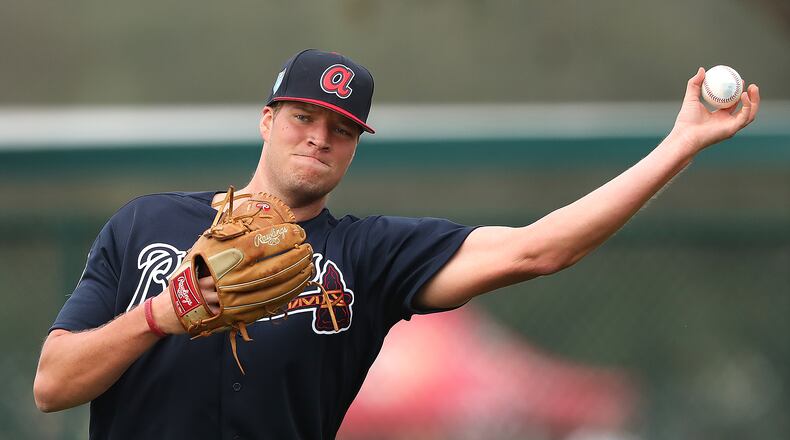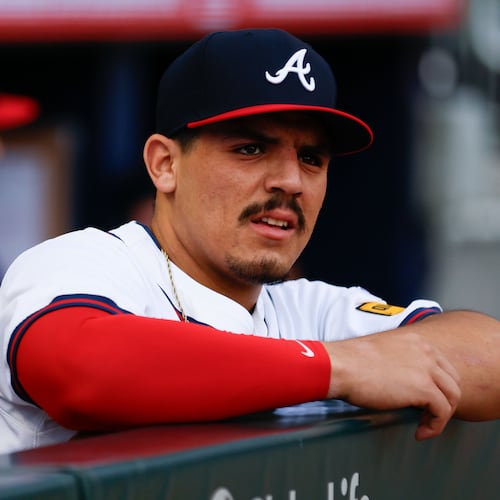Adam McCreery stands 6-foot-9 and throws from a high three-quarters arm slot, making the Braves left-hander appear gigantic to a hitter, particularly one who hasn’t seen him before.
“I’ve had a couple of lefties (hitters) come up to me and say, ‘Dude, I never want to face you again,’” McCreery said sheepishly. “But I’m sure once guys get up there they’re just focused on seeing the ball, they’re not thinking like that.”
The Southern California native might be the tallest player to wear an Atlanta Braves uniform if he makes it to the major leagues, and McCreery has shown enough in the past year to make that a legitimate possibility if he keeps improving.
He’s 25 and hasn’t pitched above Single-A, but has made significant strides since coming from the Angels in an overlooked trade for Jhoulys Chacin in May 2016.
In 38 appearances last season with low-A Rome and high-A Florida, McCreery had a 2.74 ERA and eye-opening 90 strikeouts with 38 walks and one homer allowed in 62-1/3 innings. He had an encouraging first spring-training outing Sunday when he gave up two hits in a scoreless inning with no walks against the Nationals on a windy day when several other Braves pitchers struggled with command.
“First time I’ve seen him,” said Braves manager Brian Snitker, who’s been impressed early with a few lefty bullpen hopefuls in camp including Jesse Biddle, McCreery and non-roster invitee Phil Pfeifer. “(McCreery) has got a good arm. I can see why we protected him. That big sucker’s got skills. Got a nice arm and I liked what I saw yesterday.
“For a guy that’s that big, he looks like he’s coordinated, and the delivery works.”
He doesn’t throw as hard as might be expected given his towering presence, but McCreery compliments a low-90s fastball with a curveball he began throwing two years ago, a pitch that’s had a lot to do with his progress since.
“I’ll take 90, 92 (mph fastball velocity) with movement any day,” he said. “As long as you can put it over the plate. You see a lot of guys like (Kyle) Hendricks nowadays -- he’s 87 (mph), just movement gets you to the World Series. Guys like that you’re like, ‘Ok, I don’t need to just get up there and throw as hard as I can.’ Just put it in the right spot with good movement, hopefully it goes well from there, you know?”
As for his breaking ball, “I try to be a guy who can throw it in any count for a strike, for a ball, or out of the zone for, like, a strike-3 type pitch,” McCreery said. “So far it’s been good. It’s kind of like a slurve (slider-curveball). Sometimes I’ll try to throw it a little harder to make it a little tighter. Sometimes I’ll let off to get a little more, like, slow loop to it.
“About two years ago I was in extended (spring training). I couldn’t throw my fastball for strikes, so I would just throw a ton of breakers, and it kind of just got better and better then. And I’ve had it, a good one, for about two years now.”
Lefty batters hit just .183 with a .560 OPS last season against McCreery, and right-handers didn’t fare much better with a .218 average and .579 OPS. He made substantial improvement over his first year in the Braves organization in 2016, when he posted a 4.19 ERA in 22 appearances split between rookie-league Danville and low-A Rome while averaging just under one strikeout per inning.
McCreery gives a lot of the credit for his improvement to Braves pitching gurus Dave Wallace and Dom Chiti, who returned from the Orioles to the Braves organization in November 2016 and went to work with a bevy of pitching prospects. McCreery is older than most, having spent three years at Azusa Pacific University and two seasons in the Angels organization without making it out of rookie ball.
But the arm has always been regarded as a “live” one and the Braves knew that it sometimes takes longer for big pitchers to smooth out their mechanics. And when a Braves scout saw McCreery making strides in rookie ball with the Angels in 2015, they asked for him in the trade for Chacin.
“Wally (Mike Wallace) has been really good for me. Dom Chiti has been really good,” McCreery said. “Those two guys coming over, the environment they bring, just super relaxed. Go-out-and-have-fun type of deal. So those guys have helped a lot with my development. They see you and the second they say something, you hear them talk and you think, these guys know what they’re saying.”
Despite his big strikeout total last season, McCreery was surprised when the Braves added him to the 40-man roster in November.
“I was super-excited,” he said. “I wasn’t really expecting this to be honest. But I’m happy I’m here. It’s been really cool. Like, just the guys, everyone’s super-chill and everyone’s real laid back and everyone gets along pretty good, so it’s nice having that environment and the guys welcome you. A couple of the bullpen guys, (Sam) Freeman and (Rex) Brothers, have kind of taken me – not under their wing, but they really make things simple for the new guys.”
McCreery once had aspirations of throwing 100 mph like his boyhood idol Randy Johnson, the great 6-foot-10 left-hander. Johnson was the reason that McCreery said he threw sidearm all the way through college, before converting to the more conventional arm slot after being drafted by the Angels in the 22nd round in 2014 (he had been a 14th-round pick by the Twins three years earlier as a high school senior but elected to go to college).
“I don’t know how he throws so hard from down there,” McCreery said of Johnson. “I used to throw from down there as a kid, ‘cause I loved him growing up. I always modeled myself after him. But it was hard to throw strikes from down there, for me. So once I started moving over the top, it helped me get out front more consistently with strikes, to throw more strikes.
“When I got in pro ball, they started working on all different things (with his delivery) with the Angels. I started to find some success over there. The Braves saw that and they traded for me.”
McCreery is glad they did. For a guy who grew up in Los Angeles County – La Verne, 30 miles east of L.A. – and thought when he was drafted that he’d be pitching someday for the Angels down the road from home, he has adapted quickly to the Braves organization and the South.
“I love it here. I love the organization, the fans,” McCreery said. “There’s something real special. Just because there’s so many states around Georgia that don’t have a baseball team, so you go all the way to Mississippi or Tennessee and you see a ton of Braves fans. That (regional fan base) is something you don’t see on the West Coast with all these teams everywhere, five baseball teams in California, and then you get all your random Yankee fans in L.A. So it’s so cool to see such a tight-knit baseball family in the South for the Braves.
“I’m still figuring some Southern traditions out every day, but it’s been good here, man. For sure.”
One thing he wishes we had in the South? The famous fast-food joint that Californians swear by.
“Yeah, I still miss my In-N-Out (Burger) like, every day,” he said. I crave a double-double, like, every other day. Animal style, for sure. You guys have had it? So good.”
About the Author
Keep Reading
The Latest
Featured


